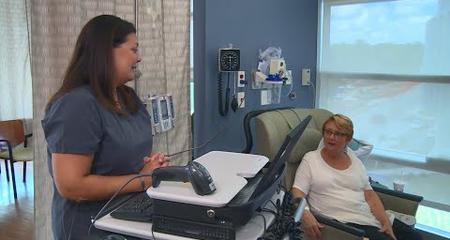Head and neck tumors may be cancerous or benign (non-cancerous). Cancers of the head and neck usually begin in the cells that line the moist surfaces of the mouth, nose and throat — the squamous cells. Head and neck cancers can also begin in the glands that produce saliva — the salivary glands.
Cancers of the head and neck usually begin in the cells that line the moist surfaces of the mouth, nose and throat — the squamous cells. Head and neck cancers can also begin in the glands that produce saliva — the salivary glands. Salivary gland cancers are relatively rare, accounting for less than 1% of cancers in the United States according to the American Cancer Society.
The majority of head and neck cancers are linked to tobacco use, but alcohol use and human papillomavirus (HPV) infection increase risk, too.
Symptoms of head and neck cancers include a lump or sore that does not heal, a sore throat that does not go away, difficulty swallowing and a change or hoarseness in the voice.
We treat all head and neck cancers, including the rarest.
- Oral Cancers — those affecting the tongue, mouth, cheeks and lips.
- squamous cell carcinoma
- verrucous carcinoma
- lymphomas
- oral cavity and oropharyngeal tumors
- Throat Cancer (Pharynx) — includes cancers of the base of the tongue and tonsils.
- anaplastic carcinoma
- papillary carcinoma
- follicular carcinoma
- oxyphil cell carcinoma
- medullary thyroid carcinoma
- HPV-Related Oropharyngeal Cancer — cancer of the tonsil and base of tongue that is directly related to a human papillomavirus (HPV) infection.
- Laryngeal Cancer — voice box or larynx cancer, includes the vocal cords.
- Sinus and Nasal Cancer — includes paranasal and skull base cancers.
- adenoid cystic carcinoma
- chordoma
- esthesioneuroblastoma
- Salivary Gland Cancer — cancer of the glands that produce saliva.
- Thyroid and Parathyroid Cancer and Tumors — disorders of the thyroid gland and parathyroid glands that impact the body’s hormonal function.
- Skin Cancer — skin cancer of the head and neck often requires the expertise of head and neck cancer physicians in addition to the resources available through the Skin Cancer Center.
Head and Neck Cancer Types and Symptoms - Video FAQ
Stuart Wong, MD, medical oncologist, describes head and neck cancer.
Head and neck cancers are a group of cancers that occur above the shoulders. They primarily occur in the mouth, the throat and the lining cells of those structures. Our professionals also take care of patients with skin cancers that occur in the head and neck region.
Stuart Wong, MD, medical oncologist, describes how the types of head and neck cancers are defined.
There are many different types of head and neck cancers, and they are primarily defined by the location at which these tumors occur. Common cancers are those that occur in the mouth, tongue or the throat. The most common ones that we are seeing these days are those that are related to HPV, and those occur in the base of the tongue and the tonsils.
Michael Stadler, MD, head and neck surgical oncologist, lists the common types of head, neck and scalp skin cancers.
The most common types of skin cancers of the head, neck and scalp include squamous cell carcinoma and basal cell carcinoma. Those are two very common skin cancers found throughout the body. They occur at greater rates in the head, neck and scalp because these areas have more sun exposure throughout a person's lifetime.
Stuart Wong, MD, medical oncologist, explains human papillomavirus (HPV) related head and neck cancer.
HPV cancers are probably the fastest growing subtype of head and neck cancer. If you look at the number of new cases of head and neck cancer over the last 10 to 20 years, HPV-related cancers are probably the fastest growing subset, while head and neck cancers related to smoking and alcohol use are decreasing steadily.
Michael Stadler, MD, head and neck head and neck surgical oncologist, explains what common skin cancers of the head and neck look like.
The most common skin cancers of the head and neck — which include squamous cell cancer and basal cell cancer, look like an ulcer or a bleeding area on the skin. Often, it simply starts as an irregularity — a spot on the skin that doesn't go away, but a change is noticeable.
Stuart Wong, MD, medical oncologist, explains common symptoms of head and neck cancer.
The most common symptoms that we see for patients that are diagnosed with head and neck cancer is commonly pain in the throat, but also patients will commonly notice a swelling in the neck. The most important thing that patients should be aware of is that those symptoms are common, but the key issue that patients run into that signify that they might have cancer is the persistence of these symptoms. So they may come and go, but they stay. And that is the sign that you should see your primary care physician.
Michael Stadler, MD, head and neck surgical oncologist, explains the aggressive skin cancer, melanoma.
Melanoma of this skin, also known as cutaneous melanoma, is a type of skin cancer that involves melanocytes — a type of skin cell that provides pigment or color to the skin. Cutaneous melanoma represents only 1% of all skin cancers. It does lead in skin cancer deaths, so many consider it to be a very aggressive skin cancer
Michael Stadler, MD, head and neck surgical oncologist, explains the cause of cutaneous melanoma.
The cause of cutaneous melanoma relates to the skin cells called melanocytes that undergo changes leading to those cancer cells progressing on the skin.
Michael Stadler, MD, head and neck surgical oncologist, explains the risks for cutaneous melanoma.
The risk factors for cutaneous melanoma include sun exposure or frequent sunburns over time, as well as family history and having a fair complexion. Because one of the main risk factors relates to sun exposure, the scalp and the head and neck region are very common areas where melanomas are found.
Michael Stadler, MD, head and neck surgical oncologist, explains the survival rates of head and neck melanoma patients.
Survival rates of melanoma of the head and neck are very similar to survival rates of melanoma overall. In early stages where melanoma is localized to just the skin, survival rates are in upwards of 95 to 99% at five years out from diagnosis.
When melanoma spreads to what we call regional areas or mainly lymph nodes in the head and neck region, that survival decreases. Even then, two-thirds of all patients five years out are alive and well.
When melanoma spreads to other parts of the body, survival also decreases, but we still have amazing therapies — including immunotherapy — to help. Those numbers continue to get better for our patients with cutaneous melanoma.
Michael Stadler, MD, head and neck surgical oncologist, explains the most common cause of non-melanoma skin cancer and lists examples.
The most common cause of nonmelanoma skin cancer (squamous cell carcinoma or cancer and basal cell cancers) is sun exposure — partly related to episodes of burns or high sun exposure. Non-sun exposure or artificial light exposure like tanning beds is a common risk factor as well.
Our goal is to provide every patient the best team-based, patient-centered head and neck cancer care. All of our physicians are linked together through a single hub so that patients and their families do not have to navigate the system alone. We work to deliver the best care as we explore all options, offer hope, and work to earn every patient’s trust.
We pledge to see and evaluate each new patient as quickly and compassionately as possible. Our group of experienced, fellowship-trained specialists and specialty caregivers works in an academic medical center where we see many patients with uncommon cancers and unusual problems. This breadth of experience promises every patient a highly-qualified and seasoned treatment team and the best possible outcomes
Ready for an appointment? We’ll work with you to expedite your appointment and see you promptly, typically within five business days. Request an appointment.
Our team includes physicians who are national leaders in head and neck cancer research and thought leaders in head and neck cancer care. We strive to bring new treatment and cutting edge experimental therapy back to our patients in Wisconsin. View more health system awards.
Excellent Outcomes
Research demonstrates that cancer patients treated at high volume academic medical centers have the best possible treatment outcomes. As a nationally-recognized academic medical center, we understand and employ the most effective research, technology, and expert knowledge in every patient’s treatment journey.
The Froedtert & MCW Skull Base Program has been designated as a North American Skull Base Society (NASBS) 2021 Multidisciplinary Team of Distinction. The NASBS strives to create an inclusive focus for the society's educational offerings, programs and members by welcoming a wide variety of health care professionals who provide skull base patient care. In keeping with that approach, they recognize member institutions that have multidisciplinary skull base surgery teams that include physicians in a variety of specialties.
Personalized, Highly Effective Head and Neck Cancer Care
There are several reasons why you should trust us with your care. Our fellowship-trained specialists and specialty caregivers have vast experience in head and neck cancer diagnosis and treatment, including the rarest.
- Top physicians. Our highly skilled physicians are specialty trained (fellowship trained) in their fields. We have worked as a team for many years — building expertise and focusing on head and neck cancer patients. We'll employ the most effective research, technology and expert knowledge in your treatment. We will also work to deliver the best care as we explore all options, offer hope and work to earn your trust. Many of our physicians are nationally as well as regionally recognized for their expertise and leadership in their respective fields.
- Team-based approach. Our team includes many other specialists who focus their practices on the needs of head and neck cancer patients.
- Head and neck surgeons
- Radiation oncologists
- Medical oncologists
- Plastic and reconstructive surgeons
- Head and neck radiologist
- Head and neck pathologist
- Dentist and oral surgeons
- Endocrinologists
- Dermatologists and dermatologic surgeons
- Ear, nose and throat specialists
- Audiologists
- Speech and language pathologists
- New patient coordinator
- Specialized cancer-focused nurse practitioners and nurses
- Physical medicine and rehabilitation specialists
- Dietitians
- Clinical research coordinators
- Quality of life specialists
- Financial navigators
- Social workers
- Genetic counselors
- Personalized care. Our team has held weekly care-planning conferences for years, reviewing every new patient’s story and discussing the latest research in order to develop a comprehensive, personalized care plan for each patient prior to beginning therapy.
Patient Story: Doctor Notices Cancerous Lump on Husband's Neck During Wife's Appointment

"I'm breathing, and I’m here today, and it’s wonderful. I have so much respect and love for Froedtert for what they did for me ..."
- Paul Moll, oropharynx cancer survivor
- Prompt evaluation. We work with you to schedule an appointment as quickly as possible, typically within five business days. We see patients from across the state and from outside of Wisconsin.
- Access to research and clinical trials. Our academic medical center offers patients more opportunities to participate in clinical trials that provide cutting-edge treatments such as: immunotherapies, targeted therapies, minimally-invasive surgical techniques and precise, adaptive radiation therapies. These trials provide leading-edge and carefully monitored treatments that will shape the future of cancer care.
- Extensive support care services. We offer patient support, including the Jeffrey C. Siegel Quality of Life Center where you have access to several cancer-focused teams including our dietitians, psycho-oncology nurses, complementary medicine providers, social workers, chaplains, financial navigators and our nationally recognized Palliative Care Program. Patients also have access to physical and occupational therapists.
Our Small Stones Wellness Center offers a wealth of resources designed especially for cancer patients, including cosmetics, wig expertise, head coverings and products that are safe for patients going through treatment. - Palliative Care Program. Our Palliative Care Program is the only one of its kind in the state. Our palliative care team focuses on symptom management and also provides support and assistance with complicated decision-making, goal setting and advance-care planning. Our specialists are leaders in palliative medicine research and education.
- Regional cancer network. In addition to Froedtert Hospital in Milwaukee, our Cancer Network includes locations in Menomonee Falls, West Bend, New Berlin, Oak Creek and Pleasant Prairie. Regardless of the Froedtert & MCW location, all of our physicians and other team members collaborate to provide you with completely coordinated care. And because we see patients from across the state and from outside of Wisconsin, we also work with physicians and caregivers at other centers, when appropriate.
Second Opinion for Head and Neck Cancer
Early treatment is critical for optimal oropharyngeal cancer survival rates. We offer a Cancer Second Opinion Program if you want to know more about your diagnosis and treatment choices. Your doctor can diagnose throat cancer with a physical exam and may use a scope with a light, or endoscope, to get a close look at your throat. When appropriate, your doctor may order a biopsy of the tissue in your throat for pathology testing or additional imaging tests. Learn more about head and neck cancer diagnostic techniques.
Virtual Visits Are Available
Safe and convenient virtual visits by video let you get the care you need via a mobile device, tablet or computer wherever you are. We’ll gather your medical records for you and get our experts’ input so we can offer treatment options without an in-person visit. To schedule a virtual visit, call 1-866-680-0505.
Recognized as High Performing by U.S. News & World Report
Froedtert Hospital is recognized by U.S. News & World Report as high performing in three adult specialties and 16 procedures and conditions, including cancer.




